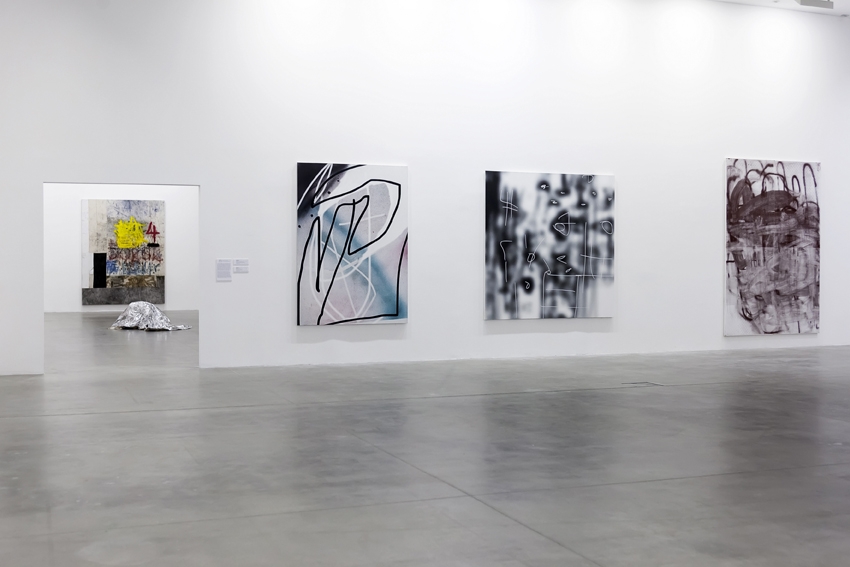At the moment there are names in the artworld that arouse suspicions: those of David Ostrowski, Oscar Murillo, Parker Ito and Ned Vena, for example. Such young abstract painters are often associated with six-figure auction prices that have yet to be legitimised by institutional or discursive support – which at first makes this art look like the paradigm of a market in which paintings change hands faster than the paint can dry. It is quite possible that the title of the exhibition Beware Wet Paint plays exactly with this suspicion. Nevertheless, the curator Gregor Muir has successfully put together a double show – at the London ICA and the Fondazione Sandretto Re Rebaudengo in Turin – which offers perhaps the most exciting overview to date of… well… post-Internet painting, as one must call it: abstract painting that feeds on online access and digital reproduction.
This scavenger approach doesn’t spare an artist’s own works either. Christopher Wool, who will be sixty this year and who acts as a guiding spirit in the exhibition, has been asking since the mid-1980s what a painting can be. Early on he transferred floral forms onto the canvas with roller stamps; then came the famous ‘word paintings’, in which sentence fragments in dripping black paint screamed at the viewer from the canvas. In contrast, a painting like Untitled (No Halloween) (2003) seems like a digital photo of graffiti that someone unsuccessfully tried to wipe off the wall. In fact, though, it is related to one of Wool’s older paintings: the artist printed the image on a new canvas and partially reworked it by hand. Wool nonchalantly discards painting’s interaction with the image sources and claim of originality. The same is true of all the younger artists in the exhibition.
Among them, and by far the oldest, is Jeff Elrod, born in 1966. His canvases look like low-quality photographs of a Jackson Pollock painting that have been zoomed-in on to such an extreme that the contours become blurred. In actuality, having developed his technique while working nightshifts in the printing house of the Houston Chronicle during the 1990s, Elrod uses Photoshop to create forms that he then projects onto the canvas and fixates with spraypaint. Here Abstract Expressionism seems at most like background noise from an era whose suffering gave way to a laconic laissez-faire.
Ned Vena’s canvases, also based on computer design programs, strike the same tone. Vena makes stencils using a digital plotting machine, subsequently spraying over these vinyl templates. Graffitilike traces remain, lending the serial minimalistic pattern a raw touch. As with many paintings in the show, digital and manual production, and urban and abstract aesthetics flow into each other. The sprayed wall-paintings by Isabelle Cornaro come across as similarly uncomplicated. At first glance one thinks of classic Colour Field painting – of flowing monochromatic reductions of landscapes. However, Cornaro’s works are anything but sublime. Her series Reproductions (2014) traces back to a 16mm film that documents the creation of ten wall paintings whose proportions are derived from the space. The Reproductions are blowups of these filmed paintings: the role of painting as reproducer of reality is reenacted, so to speak.
Cornaro’s painting has, like all the works in the exhibition, something cool, smart and completely unemotional about it. Subjectivity and content give way to the question of how painting, in a world overflowing with images, can look today without appearing completely reactionary – albeit by relying wholly on transformation processes and visual effects. If older generations carried through life the legacy of Yves Klein, Barnett Newman or Blinky Palermo as a backpack full of formal questions, today’s image producers have trained their eyes via MTV and the Internet. And in contrast to Tomma Abts or Sergej Jensen, who ten years ago tried to reanimate modern utopias and formalistic discourse, the vibe of these paintings is pure Pop. Beauty, style and sexiness are the new ingredients for a medium with which artists struggled until now, instead of simply grooving through it like through Google. This nihilism almost appears as liberation. These artists react to the -isms of the avant-garde – Suprematism, Abstract Expressionism, Minimalism, Postmodernism – like pupils in the last row: feet on the table and leaning back at ease. But when rocking the chair, one can quickly fall backwards. And then coolness just comes across as clumsiness. So one should, indeed, Beware Wet Paint!
Translated from the German by Emily Terényi
This article was first published in the January & February 2015 issue
